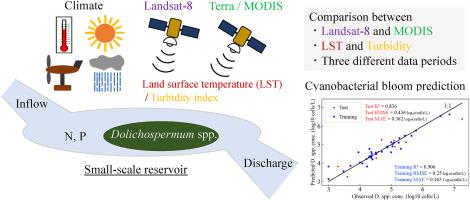Landsat-8与MODIS数据预测小规模水库蓝藻华的对比分析
IF 4.5
Q2 ENVIRONMENTAL SCIENCES
Remote Sensing Applications-Society and Environment
Pub Date : 2025-07-23
DOI:10.1016/j.rsase.2025.101672
引用次数: 0
摘要
蓝藻大量繁殖对淡水生态系统和人类活动构成重大风险。这种水华的短期预测技术提高了决策过程,以减轻其有害影响。来自地球观测卫星的数据证明,由于其对水面的一致和系统的监测,对于监测各种水生环境中的蓝藻繁殖非常宝贵。较小的水体对许多国家的供水至关重要,但在以前的研究中,利用卫星获取的数据开发蓝藻繁殖的预测模型时,在很大程度上被忽视了。MODIS具有低空间和高时间分辨率,已被用于预测包括大型湖泊和沿海地区在内的广大水体的蓝藻华。然而,据我们所知,像Landsat-8这样的高空间分辨率卫星以前还没有被用于开发小规模水体模型。在这项研究中,我们构建了预测7天提前期Dolichospermum spp.浓度的模型,使用与水质、水文、气象、Landsat-8和MODIS数据相关的变量,通过三种机器学习算法集成。Dolichospermum spp.是一种在日本小型水库中发现的形成浮渣的蓝藻属。我们建立了三个不同的卫星地表温度(LST)和归一化浊度指数(NDTI)的时间间隔,以评估它们对水华发生的时间影响。最优模型采用MODIS数据和XGBoost算法,R2值为0.84,均方根误差为0.44,单位为log10 (cells/L)。在Dolichospermum spp.爆发前23 - 38天的卫星数据使两个水库的模型最准确,其中LST的相对重要性通常高于NDTI。这项研究强调了卫星衍生的地表温度和NDTI作为准确预测小规模水库蓝藻华的关键预测指标的潜力。本文章由计算机程序翻译,如有差异,请以英文原文为准。

A comparative analysis of Landsat-8 and MODIS data for forecasting cyanobacterial blooms in small-scale reservoirs
Cyanobacterial blooms pose significant risks in freshwater ecosystems and human activities. Short-term prediction technologies of such blooms enhance decision-making processes to mitigate their detrimental impacts. Data from earth observation satellites proves invaluable for monitoring cyanobacterial blooms across diverse aquatic environments due to its consistent and systematic surveillance of water surfaces. Smaller water bodies, crucial for water supply in numerous countries, have been largely overlooked in developing predictive models for cyanobacterial blooms using satellite-derived data in previous research. With its low spatial and high temporal resolution, MODIS has been employed to forecast cyanobacterial blooms across vast water bodies, including large lakes and coastal areas. However, to our knowledge, high spatial resolution satellites such as Landsat-8 have not been previously utilized in developing models for small-scale water bodies. In this study, we constructed models to forecast Dolichospermum spp. concentrations with 7-day lead time, a genus of scum-forming cyanobacteria found in small Japanese reservoirs, using variables related to water quality, hydrology, meteorology, and Landsat-8 and MODIS data, integrated through three machine learning algorithms. We established three distinct temporal intervals for satellite-derived land surface temperature (LST) and normalized difference turbidity index (NDTI) to assess their temporal influence on bloom occurrences. The optimal model, employing MODIS data and the XGBoost algorithm, achieved an R2 value of 0.84 and a root mean squared error of 0.44 in log10 (cells/L). Satellite data from 23 to 38 days before a Dolichospermum spp. bloom enabled the most accurate models in two reservoirs, with LST generally showing higher relative importance than NDTI. This investigation emphasizes the potential of satellite-derived LST and NDTI as critical predictors in accurately predicting cyanobacterial blooms in small-scale reservoirs.
求助全文
通过发布文献求助,成功后即可免费获取论文全文。
去求助
来源期刊
CiteScore
8.00
自引率
8.50%
发文量
204
审稿时长
65 days
期刊介绍:
The journal ''Remote Sensing Applications: Society and Environment'' (RSASE) focuses on remote sensing studies that address specific topics with an emphasis on environmental and societal issues - regional / local studies with global significance. Subjects are encouraged to have an interdisciplinary approach and include, but are not limited by: " -Global and climate change studies addressing the impact of increasing concentrations of greenhouse gases, CO2 emission, carbon balance and carbon mitigation, energy system on social and environmental systems -Ecological and environmental issues including biodiversity, ecosystem dynamics, land degradation, atmospheric and water pollution, urban footprint, ecosystem management and natural hazards (e.g. earthquakes, typhoons, floods, landslides) -Natural resource studies including land-use in general, biomass estimation, forests, agricultural land, plantation, soils, coral reefs, wetland and water resources -Agriculture, food production systems and food security outcomes -Socio-economic issues including urban systems, urban growth, public health, epidemics, land-use transition and land use conflicts -Oceanography and coastal zone studies, including sea level rise projections, coastlines changes and the ocean-land interface -Regional challenges for remote sensing application techniques, monitoring and analysis, such as cloud screening and atmospheric correction for tropical regions -Interdisciplinary studies combining remote sensing, household survey data, field measurements and models to address environmental, societal and sustainability issues -Quantitative and qualitative analysis that documents the impact of using remote sensing studies in social, political, environmental or economic systems

 求助内容:
求助内容: 应助结果提醒方式:
应助结果提醒方式:


